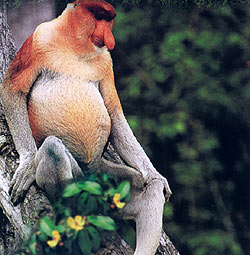- Proboscis Monkey
Taxobox
name = Proboscis MonkeyMSW3 Groves|pages=168-169]
status = EN
trend = unknown
status_system = iucn3.1
status_ref =IUCN2006|assessors=Eudey "et al"|year=2000|id=14352|title=Nasalis larvatus|downloaded=5 May 2006 Listed as Endangered (EN A2c, C1+2a v2.3)]

regnum =Animal ia
phylum =Chordata
classis =Mammal ia
ordo =Primate s
familia =Cercopithecidae
subfamilia =Colobinae
genus = "Nasalis"
genus_authority = É. Geoffroy, 1812
species = "N. larvatus"
binomial = "Nasalis larvatus"
binomial_authority = Wurmb, 1787The Proboscis Monkey ("Nasalis larvatus"), also known as the Monyet Belanda (in Malay), the Bangkatan (in Indonesian) or simply the Long-nosed Monkey, is a reddish-brown
arboreal Old World monkey that is endemic to thesouth-east Asia n island ofBorneo . It belongs in themonotypic genus "Nasalis", although thePig-tailed Langur traditionally also has been included in this genus - a treatment still preferred by some. [Bradon-Jones, D., A. A. Eudey, T. Geissmann, C. P. Groves, D. J. Melnick, J. C. Morales, M. Shekelle, and C. B. Stewart. 2004. "Asian primate classification." International Journal of Primatology. 23: 97-164.]Appearance
A distinctive trait of this
monkey is the male's large protrudingnose , from which it takes its name. The nose is thought to be used in mating and is unique to the males of the species, reaching up to 7 inches in length. Besides attracting mates, the nose serves as a resonating chamber and works by amplifying their warning calls. When the animal becomes agitated its nose swells with blood, making warning calls louder and more intense. [ [http://www.bbc.co.uk/nature/wildfacts/factfiles/319.shtml Proboscis monkey, long-nosed monkey] BBC]Males are much larger than females, reaching 72 cm (28
inch es) in length, with an up to 75 cm tail, and weighing up to 24 kg (53 pounds). Females are up to 60 cm long, weighing up to 12 kg (26 lb). This large sexual dimorphic difference is greater than in any other primate.The Proboscis Monkey also has a large belly, as a result of its diet.Fact|date=January 2008 Its
digestive system is divided into compartments, with bacteria that digest cellulose and neutralize toxins from certain leaves. This lets the monkey eat leaves and remain in the forest canopy. The contents of their stomach weigh about a quarter of their whole body. [ [http://www.blueplanetbiomes.org/proboscis_monkey.htm Proboscis Monkey] blueplanetbiomes.org] A side-effect of this unique digestive system is that it is unable to digest ripefruit , unlike most othersimian s.Fact|date=October 2007 The diet consists mainly of seeds, leaves, mangrove shoots and unripe fruit. [ [http://animaldiversity.ummz.umich.edu/site/accounts/information/Nasalis_larvatus.html Nasalis larvatus] Animal Diversity Web]Ecology
The Proboscis Monkey is endemic to Borneo's low elevation mangrove forests,
swamps , and lowlandriparian forest s.cite journal | author = Meijaard, Erik & Vincent Nijman | title = Distribution and conservation of the proboscis monkey (Nasalis larvatus) in Kalimantan, Indonesia | journal = Biological Conservation | volume = 92 | issue = 1 | pages = 15–24 | month = January | year = 2000 | doi =10.1016/S0006-3207(99)00066-X | accessdate = 2008-01-10] It lives in small groups of 10 to 32 animals. Group membership is very flexible, and animals are known to move from group to group quite often.The Proboscis Monkey lifestyle is both arboreal and amphibious, with its mangrove swamp and riverine environment containing forest, dry land, shallow water allowing wading, and deep water requiring swimming. Like other similar monkeys, the Proboscis Monkey climbs well. It is also a proficient swimmer, often swimming from island to island, and has been picked up by fishing boats in open ocean a mile from shore. While wading, the monkey uses an upright posture, with the females carrying infants on their hip. Troops have been filmed continuing to walk upright, in single file, along forest trails when they emerge on land, the only non-human mammal, with the exception of
gibbon s andgiant pangolin s, known to use this form of locomotion for any length of time.tatus
Due to ongoing
habitat loss and hunting in some areas, only about 7000 are known to still exist in the wild. InSarawak , the population of this species has declined from 6500 in 1977 to only 1000 in 2006. The Proboscis Monkey is evaluated asEndangered on theIUCN Red List of Threatened Species. It is listed on Appendix I ofCITES .Other names
While the official Indonesian name for this monkey is Bangkatan, an Indonesian nickname is 'monyet belanda', meaning 'Dutch monkey' or 'Orang Belanda', the Indonesian word for 'Dutchman', as Indonesians noticed the Dutch colonisers often also had a large belly and nose.
References
External links
* ARKive - [http://www.arkive.org/species/GES/mammals/Nasalis_larvatus/ images and movies of the Proboscis monkey "(Nasalis larvatus)"]
* [http://pin.primate.wisc.edu/factsheets/links/nasalis Primate Info Net "Nasalis" Factsheets]
* [http://www.proboscismonkey.org/ Save the Proboscis Monkeys] Petition and weblog with info on the rare, endangered species.
* [http://video.nationalgeographic.com/video/player/animals/mammals-animals/monkeys-and-lemurs/monkey_proboscis_captivity.html National Geographic video]
Wikimedia Foundation. 2010.
